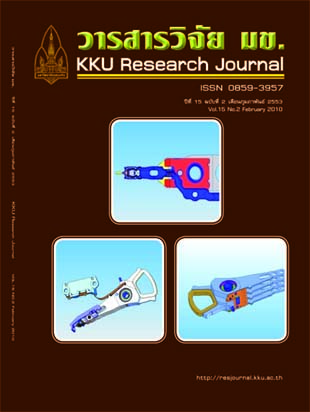Screening landrace Thai rice in north and northeast regions of Thailand for rice blast resistance gene, Pi-d2, with DNA marker (Thai)
Main Article Content
Abstract
Rice blast disease caused by the fungal pathogen Magnaporthe grisea, is one of the most devastating
diseases in rice worldwide. Information on rice with disease resstance gene is important for rice cultivar
development. In this study, 69 landrace Thai rice cultivars including 24 cultivars from the North and 45
cultivars from the Northeast regions of Thailand were collected for examination for the presence of gene
Pi-d2 by using one pair of Pi-d2 specific primer (Pi-d2 Con2F/Con2R). DNA from all Thai landrace rice cultivars
can be amplified. The amplified DNA fragments can be classified into two alleles. 39 rice cultivars have
the resistant Pi-d2 allele of rice blast disease resistance gene, 7 cultivars from the North and 32 cultivars
from the Northeast regions. The sequence comparison analysis between resistant and susceptible alleles
from landrace Thai rice cultivars and Nipponbare, a susceptible check cultivar, showed a single nucleotide
polymorphism (SNP) A/G presents in the recognition site of MluI . The resistant allele, allele R,has a 5'
A*CGCGT-3' sequence, the recognition site of MluI, therefore produces 700 and 400 bp after MluI
digestion. While the susceptible allele, allele S, has 5'-G*CGCGT-3', which cannot be cut by MluI
enzyme, so it remains to produce 1,100 bp after MluI digestion.
diseases in rice worldwide. Information on rice with disease resstance gene is important for rice cultivar
development. In this study, 69 landrace Thai rice cultivars including 24 cultivars from the North and 45
cultivars from the Northeast regions of Thailand were collected for examination for the presence of gene
Pi-d2 by using one pair of Pi-d2 specific primer (Pi-d2 Con2F/Con2R). DNA from all Thai landrace rice cultivars
can be amplified. The amplified DNA fragments can be classified into two alleles. 39 rice cultivars have
the resistant Pi-d2 allele of rice blast disease resistance gene, 7 cultivars from the North and 32 cultivars
from the Northeast regions. The sequence comparison analysis between resistant and susceptible alleles
from landrace Thai rice cultivars and Nipponbare, a susceptible check cultivar, showed a single nucleotide
polymorphism (SNP) A/G presents in the recognition site of MluI . The resistant allele, allele R,has a 5'
A*CGCGT-3' sequence, the recognition site of MluI, therefore produces 700 and 400 bp after MluI
digestion. While the susceptible allele, allele S, has 5'-G*CGCGT-3', which cannot be cut by MluI
enzyme, so it remains to produce 1,100 bp after MluI digestion.
Article Details
How to Cite
Srikeaw, E. .-. O., Jantasuriyarat, C., & Kate-ngam, S. (2017). Screening landrace Thai rice in north and northeast regions of Thailand for rice blast resistance gene, Pi-d2, with DNA marker (Thai). Asia-Pacific Journal of Science and Technology, 15(2), 123–131. retrieved from https://so01.tci-thaijo.org/index.php/APST/article/view/83149
Section
Research Articles
References
-


